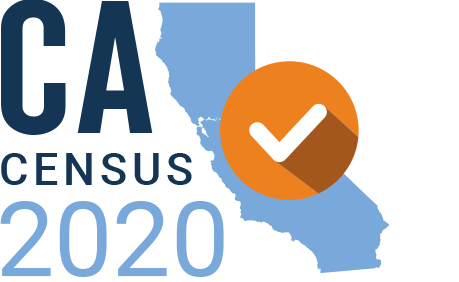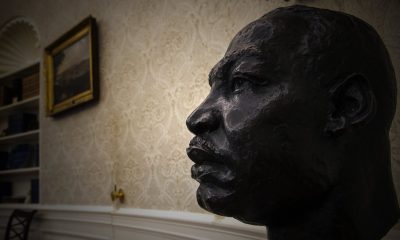Bay Area
Hiring Black Census Employees in California Could Avert an Undercount in 2020

The California Census Office believes there will be higher participation among African Americans during next year’s census if “trusted messengers” help get the word out and go door-to-door conducting pre-surveys, educating people and helping some fill out questionnaires in Black communities.
Preparing for the 2020 Census, the U.S. Census Bureau is in the process of hiring about 500,000 workers across the country for the national count that will cost the federal government a little over $15 billion.
Tens of thousands of temporary federal employees will join the effort in California to assist with collecting data and reaching out to citizens on the internet, by phone and in person.
Pay is based on location and position. In larger cities like Sacramento, Los Angeles, and San Francisco, salaries range anywhere from $17.00 to $30.00 per hour for field representative positions.
All applicants must be US citizens, although special exemptions have been made in the past for people with specific languages skills.
“This is really an opportunity for Black Californians to help make sure there isn’t a wrong assessment of our state’s population,” said Regina Wilson, president of California Black Media. Her organization recently released a report titled “Counting Black California,” designed to help media publications across the state micro-target hard-to-count populations and expand the reach of their public education efforts around the census.
“Census counts have real impact on people’s lives,” said Wilson, “from our representation in Congress to the amount of federal aid a neighborhood receives for programs like Head Start.”
The national Census, conducted every 10 years, is mandated by the United States Constitution. It records critical demographic information about residents of every state in the country and it is used to determine political representation in the U. S. Congress, as well as provide important insights into the economy.
Some of the data the bureau collects are obtained using household surveys. The exercise produces statistics that describe populations in detail by characteristics such as age, education, housing, and income.
For the first time in history next year, the U.S. Census Bureau is requesting that the majority of participants provide the answers to their Census questionnaires online.
A digital census could pose specific challenges to accurately counting African Americans. Even though smartphones and other mobile devices have helped to close the gap between Whites and Blacks with access to the internet, only about 66 percent of African Americans own a computer or laptop at home, according to a report by the Pew Research Center.
Also, significant numbers of African Americans still do not have wireless or broadband internet connections at home.
More than one-third of California’s 2.2 million Black population lives in the Los Angeles area, where there is a large number of tracts the U.S. Census Bureau designates as “hard-to-count” because of inaccurate population totals in the past.
For the 2020 Census, California is investing near $180 million statewide through various programs in an effort to make certain that residents of the state are informed about all aspects of the national survey.
“California is proud to be dedicating targeted funding and resources toward outreach to hard-to-count demographic populations across the state,” said Ditas Katague, director of California Complete Count – Census 2020.
Since the inception of the Census, Black communities have been routinely undercounted. The reasons for the inaccurate count in the last decennial, census researchers say, included the large number of Blacks who move frequently; multigenerational families living in the same home; homes with multiple families sometimes living in different units at the same address that census workers may not recognize; teen single mothers; homelessness; high rates of incarceration; and a general reluctance to participate based on inadequate information.
While the margins of uncounted Blacks seem to decrease after every 10 years, the last decennial in 2010 still undercounted the Black population by close to 800,000 people.
Activism
Oakland Post: Week of May 21 – 27, 2025
The printed Weekly Edition of the Oakland Post: Week of May 21 – 27, 2025

To enlarge your view of this issue, use the slider, magnifying glass icon or full page icon in the lower right corner of the browser window.
Bay Area
Chevron Richmond Installs Baker Hughes Flare.IQ, Real-time Flare Monitoring, Control and Reduction System
While the sight of flaring can cause concern in the community, flares are essential safety systems that burn pollutants to prevent them from being released directly into the atmosphere. They activate during startup and shut-down of facility units or during upsets or equipment malfunctions. The typical flare stack is about 200 feet high so that vapors are well above street levels.

The Richmond Standard
Chevron Richmond recently installed flare.IQ, a real-time, automated system that will improve the facility’s flaring performance.
The technology, developed by Panametrics, a Baker Hughes business, uses sensors to monitor, reduce and control flaring in real time. It collects and assesses data on refinery processes, such as temperature, pressure, gas flow and gas composition, and adjusts accordingly to ensure flares burn more efficiently and cleanly, leading to fewer emissions.
“The cleaner the flare, the brighter the flame can look,” said Duy Nguyen, a Chevron Richmond flaring specialist. “If you see a brighter flame than usual on a flare, that actually means flare.IQ is operating as intended.”
While the sight of flaring can cause concern in the community, flares are essential safety systems that burn pollutants to prevent them from being released directly into the atmosphere. They activate during startup and shut-down of facility units or during upsets or equipment malfunctions. The typical flare stack is about 200 feet high so that vapors are well above street levels.
“A key element in Baker Hughes’ emissions abatement portfolio, flare.IQ has a proven track record in optimizing flare operations and significantly reducing emissions,” said Colin Hehir, vice president of Panametrics, a Baker Hughes business. “By partnering with Chevron Richmond, one of the first operators in North America to adopt flare.IQ, we are looking forward to enhancing the plant’s flaring operations.”
The installation of flare.IQ is part of a broader and ongoing effort by Chevron Richmond to improve flare performance, particularly in response to increased events after the new, more efficient hydrogen plant was brought online in 2019.
Since then, the company has invested $25 million — and counting — into flare minimization. As part of the effort, a multidisciplinary refinery team was formed to find and implement ways to improve operational reliability and ultimately reduce flaring. Operators and other employees involved in management of flares and flare gas recovery systems undergo new training.
“It is important to me that the community knows we are working hard to lower emissions and improve our flaring performance,” Nguyen said.
Also evolving is the process by which community members are notified of flaring incidents. The Community Warning System (CWS), operated by Contra Costa County is an “all-hazard” public warning system.
Residents can opt-in to receive alerts via text, e-mail and landline. The CWS was recently expanded to enable residents to receive notifications for “Level 1” incidents, which are considered informational as they do not require any community action.
For more information related to these topics, check out the resources included on the Chevron Richmond, CAER and Contra Costa Health websites. Residents are also encouraged to follow @chevronrichmond and @RFDCAOnline on Facebook and X (formerly Twitter), where additional information may be posted during an incident.
Activism
Oakland Hosts Town Hall Addressing Lead Hazards in City Housing
According to the city, there are 22,000 households in need of services for lead issues, most in predominantly low-income or Black and Latino neighborhoods, but only 550 to 600 homes are addressed every year. The city is hoping to use part of the multimillion-dollar settlement to increase the number of households served each year.

By Magaly Muñoz
The City of Oakland’s Housing and Community Development Department hosted a town hall in the Fruitvale to discuss the efforts being undertaken to remove lead primarily found in housing in East and West Oakland.
In 2021, the city was awarded $14 million out of a $24 million legal settlement from a lawsuit against paint distributors for selling lead-based paint that has affected hundreds of families in Oakland and Alameda County. The funding is intended to be used for lead poisoning reduction and prevention services in paint only, not water or other sources as has been found recently in schools across the city.
The settlement can be used for developing or enhancing programs that abate lead-based paint, providing services to individuals, particularly exposed children, educating the public about hazards caused by lead paint, and covering attorney’s fees incurred in pursuing litigation.
According to the city, there are 22,000 households in need of services for lead issues, most in predominantly low-income or Black and Latino neighborhoods, but only 550 to 600 homes are addressed every year. The city is hoping to use part of the multimillion-dollar settlement to increase the number of households served each year.
Most of the homes affected were built prior to 1978, and 12,000 of these homes are considered to be at high risk for lead poisoning.
City councilmember Noel Gallo, who represents a few of the lead-affected Census tracts, said the majority of the poisoned kids and families are coming directly from neighborhoods like the Fruitvale.
“When you look at the [kids being admitted] at the children’s hospital, they’re coming from this community,” Gallo said at the town hall.
In order to eventually rid the highest impacted homes of lead poisoning, the city intends to create programs and activities such as lead-based paint inspections and assessments, full abatement designed to permanently eliminate lead-based paint, or partial abatement for repairs, painting, and specialized cleaning meant for temporary reduction of hazards.
In feedback for what the city could implement in their programming, residents in attendance of the event said they want more accessibility to resources, like blood testing, and information from officials about lead poisoning symptoms, hotlines for assistance, and updates on the reduction of lead in their communities.
Attendees also asked how they’d know where they are on the prioritization list and what would be done to address lead in the water found at several school sites in Oakland last year.
City staff said there will be a follow-up event to gather more community input for programming in August, with finalizations happening in the fall and a pilot launch in early 2026.
-

 #NNPA BlackPress3 weeks ago
#NNPA BlackPress3 weeks agoMLK Bust Quietly Removed from Oval Office Under Trump
-

 Activism3 weeks ago
Activism3 weeks agoOakland Post: Week of May 7 – 13, 2025
-

 Activism3 weeks ago
Activism3 weeks agoOakland Post: Week of April 30 – May 6, 2025
-

 #NNPA BlackPress3 weeks ago
#NNPA BlackPress3 weeks agoTrump Abruptly Fires First Carla Hayden: The First Black Woman to Serve as Librarian of Congress
-

 Activism1 week ago
Activism1 week agoNew Oakland Moving Forward
-

 Activism1 week ago
Activism1 week agoAfter Two Decades, Oakland Unified Will Finally Regain Local Control
-

 #NNPA BlackPress3 weeks ago
#NNPA BlackPress3 weeks agoBlack America Celebrates African Descent Heritage of Pope Leo XIV
-

 Activism2 weeks ago
Activism2 weeks agoOakland Post: Week of May 14 – 20, 2025











































